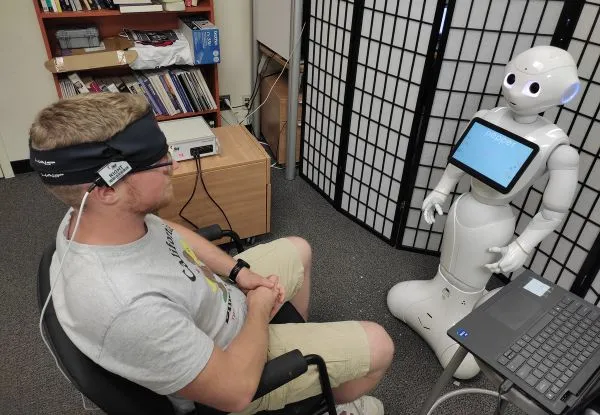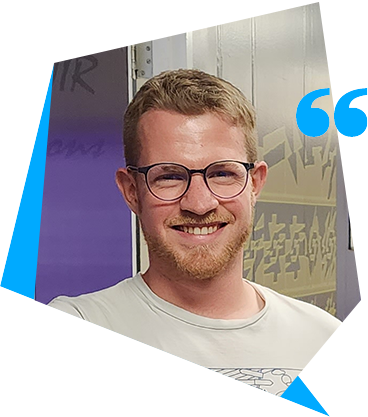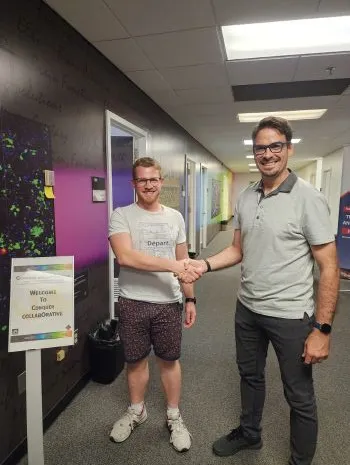< back to articles
4 months in Philadelphia for his research project
Published on
Jules Gomel took a break during his final year of the Master of Science in aerospace engineering program at ISAE-SUPAERO: he spent 4 months doing a research internship in neuroergonomics at Drexel University in Philadelphia. The Foundation awarded him a scholarship in early 2023 to facilitate his departure for the United States. Working in a cutting-edge neuroscience laboratory, Jules was able to deepen his knowledge of the world of neuroergonomics research. He tells us all about his stay!

Tell us about your project
I did a 4-month internship in Philadelphia in a cutting-edge neuroscience laboratory under the supervision of Dr. Hasan Ayaz, who leads some of the most innovative research in the field. I came into contact with these disciplines during one of my previous internships, and this is how my interest in neuroengineering and neuroergonomics developed.
Thanks to the sound advice of Dr Frédéric Dehais, professor and researcher in the neuroergonomics laboratory at ISAE-SUPAERO, I was able to find out more about the world of research at the school, the thesis path and contacts with international researchers. In this way, I came into contact with Dr Hasan Ayaz to do an internship in his laboratory for my second semester of my gap year, and I was able to take advantage of this opportunity. with a twofold objective in mind: to deepen my knowledge of the world of neuroergonomics research to confirm my desire to continue with a thesis in this field at ISAE-SUPAERO, and work in an international context in a key research country.
How did it go for you on site?
Jules Gomel

It was the first time I’d gone off on my own, so far from my landmarks, so I knew this trip would be unique and memorable. Once I arrived in Philadelphia and before starting my internship, I was able to take part in a conference organized by Drexel University: the NorthEast BioEngineering Conference (NEBEC) 2023, which brought together a large number of researchers from the northeastern United States for lectures and poster presentations.
The conference was punctuated by contributions from leading researchers in the field. This was a very important part of my internship, as I was able to integrate directly into my team and my field of research with very interesting and motivating lectures.
Tell us about your first days in the lab:
I was a Research Technician in this laboratory, sharing an office with thesis students, including a Brazilian, a Saudi and a Turk. I particularly enjoyed working with these colleagues from all over the world, who are now friends. I began my internship with a month-long introduction to neuroergonomics. In particular, I was able to help my colleagues with experiments, assisting them with various tasks ranging from data processing to assistance during data collection. As well as helping out, I was able to take part in two experiments:
- A study of differences in cognitive load with an fNIRS headband when completing three-dimensional puzzles, with Tetris-style shapes, in three different contexts: in the real world, on a computer screen and with a virtual reality headset.
- A study of the social ties between a human and a robot assistant. To do this, the researcher studied biomarkers contained in human saliva and brain activity using fNIRS before and after a series of cooperative tasks such as spelling a word in pairs with the robot, a discussion or cooperative calculations.
It was extremely interesting to be a participant, because I was able to see everything that’s involved, from both the researcher’s and the participant’s point of view. I think it was one of the highlights of my internship.
And after the first month?
After familiarizing myself with neuroergonomics, I was able to work on developing and training different models to generate the missing data. These include generators using Long Short-Term Memory (LSTM) layers, which are widely used to generate both text and time series, as well as Generative Adversarial Networks (GAN), based on parallel training of a neural network that generates the data and another that must decide whether or not the data generated is realistic.
In addition to my project, I took part in all the activities offered by this laboratory:
- I have given several presentations of articles in English at the laboratory’s technical group meetings, with the aim of sharing the latest advances and critically analyzing articles in a specific field.
- I was able to attend a large number of conferences given by colleagues and other researchers in the United States, presenting their latest advances in fields related to neuroergonomics.

What were your impressions of life in the United States?
On my weekends, I traveled to New York, Washington DC and BostonAmong other things, to discover some of the world’s most important cities and famous monuments such as the White House, the Twin Towers memorial, Central Park and universities like Harvard and the Massachusetts Institute of Technology.
I also played a number of team sports using the university’s facilities, such as soccer and athletics. At first, it was difficult to arrive in a place without knowing anyone and without friends, but as time went by, I met some extraordinary people and made friends that I’ll keep even after this internship.
In conclusion, what do you take away from this experience?
I was able to work on a concrete, rigorous and complex project that enabled me to put into practice the skills I had learned at school, but I was also able to develop my communication skills with my various oral presentations, skills that I will use in my professional future.
What’s more, as I had hoped, I was able to learn a lot more about the world of research, which enabled me to confirm my desire to continue with a thesis, with far fewer doubts than before this internship. I’ve achieved my professional goals and I’ve come out of this course stronger and ready for what’s to come.
After a difficult third semester in terms of motivation, I was able to regain my confidence thanks to this internship and I’m now approaching my third year with the utmost determination. I would therefore like to thank the Foundation for its constant support in the realization of my project.